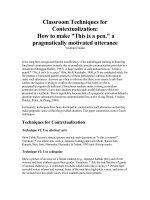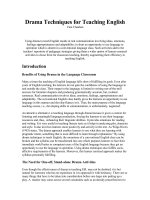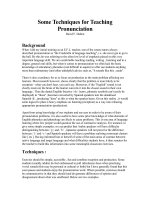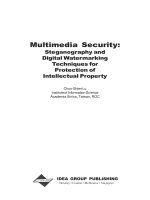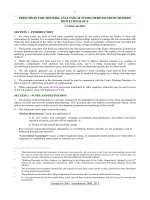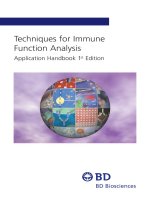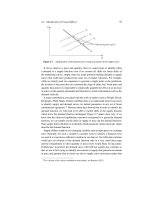Novel microextraction techniques for aqueous environmental analysis
Bạn đang xem bản rút gọn của tài liệu. Xem và tải ngay bản đầy đủ của tài liệu tại đây (1.83 MB, 201 trang )
NOVEL MICROEXTRACTION TECHNIQUES FOR
AQUEOUS ENVIRONMENTAL ANALYSIS
HII TOH MING
(M.Sc., University of Technology Malaysia)
A THESIS SUBMITTED
FOR THE DEGREE OF DOCTOR OF PHILOSOPHY
DEPARTMENT OF CHEMISTRY
NATIONAL UNIVERSITY OF SINGAPORE
2012
i
Thesis Declaration
The work in this thesis is the original work of HII TOH MING, performed
independently under the supervision of PROF. LEE HIAN KEE, in Microextraction,
Separation Science and Enviroanalytics Laboratory (S5-02-01), Chemistry
Department, National University of Singapore, between Jan 2005 and Oct 2009.
The content of the thesis has been partly published in:
(1) T.M. Hii, C. Basheer, H.K. Lee, Commercial polymeric fiber as sorbent for
solid-phase microextraction combined with high-performance liquid
chromatography for the determination of polycyclic aromatic hydrocarbons in
water, J. Chromatogr. A, 1216 (2009) 7520.
HII TOH MING
12 Oct 2013
Name Signature Date
ii
Acknowledgements
Many wonderful individuals
have encouraged and inspired this work.
I thank them all, with all my heart, and in particular I wish to thank:
Prof Lee Hian Kee, project supervisor, for his guidance, encouragement,
support and patience throughout my entire Ph.D. study. His passion and commitment
for research truly motivated and inspired me to pursue what I believe in.
Dr Chanbasha Basheer, Mdm Frances Lim, Dr Guo Liang, Dr Zhang Jie, Dr
Wu Jingming, Dr Xu Li, Dr Lee Jingyi, mentors, colleagues and friends, who all
contributed in many ways.
National University of Singapore, which generously provided financial
support, for my research scholarship, conference allowance and project funding.
Dr Wang Sang, Dr Wang Chunlei, Dr Liu Mingtao, and church brothers and
sisters in Silicon Valley, California, for their help, encouragement and prayers during
the time I was writing the thesis.
My family members, for their endless understanding and loving support.
My baby Asher, my greatest inspiration in the present and my greatest hope
for the future.
Last, but certainly not least, my beloved wife, Cathy, for her life, joy and love.
Soli Deo Gloria!
iii
Table of Contents
Thesis Declaration i
Acknowledgements ii
Table of Contents iii
Summary vii
List of Tables ix
List of Figures x
Acronyms and Abbreviations xiii
Chapter 1 Introduction
1.1 The Blue Planet
1.2 Environment Analysis and Sample Preparation
1.3 Conventional Extraction Techniques
1.3.1 Liquid-Liquid Extraction
1.3.2 Soxhlet Extraction
1.3.3 Ultrasound-Assisted Extraction
1.3.4 Supercritical Fluid Extraction
1.3.5 Pressurized Liquid Extraction
1.3.6 Microwave-Assisted Extraction
1.3.7 Solid-Phase Extraction
1.3.8 Static Headspace
1.3.9 Purge and Trap
1.3.10 Comparison of Conventional Extraction Techniques
1.4 Solventless Microextraction Techniques
1
1
2
7
8
9
10
12
13
15
17
21
22
23
23
iv
1.4.1 Solid-Phase Microextraction
1.4.2 Stir Bar Sorptive Extraction
1.4.3 Single-Drop Microextraction
1.4.4 Hollow Fiber Liquid-Phase Microextraction
1.4.5 Dispersive Liquid-Liquid Microextraction
1.4.6 Comparison of Solventless Microextraction Techniques
1.5 Derivatization in Microextraction
1.6 Objective of This Work
28
34
35
41
52
58
58
64
Chapter 2 Commercial Polymeric Fiber as Sorbent for Solid-Phase
Microextraction Combined with High-Performance Liquid
Chromatography for the Determination of Polycyclic
Aromatic Hydrocarbons in Water
2.1 Introduction
2.2 Experimental
2.2.1 Chemicals and Materials
2.2.2 Instrumentation
2.2.3 Extraction Procedures
2.3 Results and Discussion
2.3.1 Properties of Kevlar Fiber
2.3.2 Optimization of Extraction Procedures
2.3.3 Method Validation
2.3.4 Analysis of Genuine Samples
2.4 Conclusions
66
66
71
71
73
75
76
76
78
82
83
86
v
Chapter 3 Use of Commercial Polymeric Fiber for Solid-Phase
Microextraction Coupled with High-Performance Liquid
Chromatography for the Analysis of Parabens in Water
Samples
3.1 Introduction
3.2 Experimental
3.2.1 Chemicals and Materials
3.2.2 Instrumentation
3.2.3 Extraction Procedures
3.3 Results and Discussion
3.3.1 Optimization of Extraction Procedures
3.3.2 Method Validation
3.3.3 Analysis of Genuine Samples
3.4 Conclusions
87
87
91
91
94
95
95
95
103
107
107
Chapter 4 Agitation-Assisted Dispersive Liquid-Liquid
Microextraction Combined with Hollow Fiber Liquid-
Phase Microextraction for the Determination of Bisphenol
A in Environmental Water Samples
109
4.1 Introduction
4.2 Experimental
4.2.1 Chemicals and Materials
4.2.2 Instrumentation
4.2.3 Extraction Procedures
4.2.4 Injection Port Derivatization
4.3 Results and Discussion
4.3.1 Optimization of Extraction Procedures
109
114
114
116
117
118
119
119
vi
4.3.2 Method Validation
4.3.3 Analysis of Genuine Samples
4.4 Conclusions
127
129
131
Chapter 5 Conclusions and Recommendations
5.1 Concluding Remarks
5.2 Future Outlook
133
133
135
References 138
List of Publications 184
vii
Summary
Sample preparation is the main bottleneck of the analytical process, especially
when trace analysis is the purpose. The high demand for sustainable and more
environmentally benign procedures in environmental analysis has driven the
development of solventless microextraction techniques. The purpose of the this study
was to develop novel SPME and LPME based microextraction techniques for the
extraction and determination of trace organic pollutants in the environmental aqueous
samples.
Chapter 1 briefly described the importance and necessity of sample
preparation in environmental monitoring and analysis. It also included detailed
discussion of conventional extraction techniques and solventless microextraction
techniques, as well as their applications in environmental analysis. The advantages
and disadvantages of each approach were depicted in table for comparison.
Additionally, the niche of microextraction combined with derivatization in analytical
chemistry was also discussed.
Chapter 2 and 3 reported the development of a novel SPME based
microextraction method making use of commercial polymer fiber as sorbent for the
determination of polycyclic aromatic hydrocarbons and parabens in rainwater and
wastewater samples, respectively. In this technique, the extraction device was simply
a length of a strand of commercial polymeric Kevlar fiber, that was allowed to tumble
freely in the aqueous sample during extraction. The extracted analytes were desorbed
ultrasonically prior to HPLC analysis. Under the optimal conditions, the proposed
viii
method showed good linearity ranges, low limits of detection and satisfactory of
precisions. The advantage of this polymeric fiber-based SPME method over classical
SPME was the robustness of Kevlar fiber, thus it could be used as an extraction
device directly without any fabricated device or supported apparatus. The cost-
effectiveness of this method was proved by repeated use of a single fiber without
deterioration in extraction capability and free of carryover problem. This method
gave excellent recovery in various environmental water. In additionally, the good
storage performance of the Kevlar fiber also demonstrated the portability of this novel
technique for the on-site sampling.
Chapter 4 reported the possibility of using combination of two solvent
microextraction approaches, i.e. agitation-assisted DLLME (AA-DLLME) and hollow
fiber LPME (HF-LPME) for extracting and analyzing BPA in canal water, pond water
and seawater samples. Initially, the AA-DLLME was performed using an extraction
solvent with density lower than water, and subsequently followed by HF-LPME.
After extraction, the extract within hollow fiber was injected together with
derivatization reagent for GC-MS analysis. Under optimal conditions, linear range of
four orders of magnitude, excellent limit of detection, good recovery and repeatability
were achieved. The elimination of disperser solvent greatly reduced the solvent
consumption and expanded the choice of solvents for solvent microextraction.
Chapter 5 concluded the present project, described the future prospect of the
developed methods, and recommended the future works.
ix
List of Tables
Table 1.1
Examples of ubiquitous water pollutants
3
Table 1.2
Advantages and disadvantages of conventional extraction
techniques
24
Table 1.3
Advantages and disadvantages of solventless microextraction
techniques
59
Table 2.1
Optimized fluorescence detection program used for PAHs
determination
74
Table 2.2
Quantitative results of PAHs extraction from water samples
using Kevlar fiber
84
Table 2.3
Concentration of PAHs in rainwater samples
85
Table 3.1
Intraday and interday precision of the proposed method
103
Table 3.2
Quantitative results of parabens extraction from water samples
using Kevlar fiber
104
Table 3.3
Extraction relative recoveries obtained by proposed method
on spiked wastewater samples
106
Table 3.4 Concentration of parabens found in wastewater samples
107
Table 4.1
Quantitative results and experimental parameters of the
proposed method and other solventless techniques for BPA
extraction in water samples
128
Table 4.2
Concentration of BPA found in environmental water samples
130
Table 4.3
Relative recovery obtained by proposed technique on spiked
environmental water samples
130
x
List of Figures
Figure 1.1
Common steps in an analytical process
5
Figure 1.2
Number of sample preparation steps required per sample
6
Figure 1.3
Classification of conventional extraction techniques
8
Figure 1.4 Typical steps involved in solid-phase extraction
19
Figure 1.5
Method selection guide for the isolation of organic
compounds from solution. SAX, strong anion exchanger;
SCX, strong cation exchanger; WCX, weak cation exchanger;
RP, reversed-phase sampling conditions; NP, normal-phase
sampling conditions; IE, ion-exchange sampling conditions
20
Figure 1.6
Extraction of analytes by (a) fiber and (b) in-tube SPME
29
Figure 1.7
Extraction process by (a) headspace and (b) direct immersion
SPME, and desorption systems for (c) GC and (d) HPLC
analyses
31
Figure 1.8
Modes of SPME operation: (a) direct immersion, (b)
headspace and (c) membrane-protected SPME
31
Figure 1.9
Schematic diagram of (a) direct immersion and (b) headspace
SDME
36
Figure 1.10
Schematic diagram of liquid-liquid-liquid microextraction
38
Figure 1.11
Schematic illustration of (a) continuous-flow microextraction
and (b) cycle-flow microextraction
39
Figure 1.12
Schematic diagram of drop-to-drop solvent microextraction
40
Figure 1.13
Schematic illustration of (a) two- and (b) three-phase HF-
LPME
43
Figure 1.14
Cross-section of polypropylene hollow fiber
44
Figure 1.15
Technical setup for LPME based on (a) U-shaped fiber and
(b) rod-like fiber
46
Figure 1.16
The experimental setup of solvent bar microextraction
48
Figure 1.17
Schematic setup for the fiber-in-tube LPME system
49
Figure 1.18
LPME based on (a) passive diffusion, (b) pH gradient and (c) 50
xi
electric field
Figure 1.19
Schematic illustration of the equipment for EME
51
Figure 1.20
Schematic diagram of dispersive liquid-liquid microextraction
procedure
54
Figure 1.21
Summary of derivatization techniques
60
Figure 1.22
Direct derivatization in the sample matrix
60
Figure 1.23
Simultaneous on-fiber derivatization and analytes sampling
62
Figure 1.24
Derivatization on the SPME fiber after analytes sampling
62
Figure 2.1
Chemical structures of PAHs
72
Figure 2.2
Chemical structure of Kevlar
73
Figure 2.3 Schematic of the extraction apparatus
75
Figure 2.4
SEM micrograph of Kevlar fiber at 2000× magnification
78
Figure 2.5
Effect of extraction time on extraction efficiency
79
Figure 2.6
Effect of desorption time on extraction efficiency
80
Figure 2.7
Effect of desorption solvent on extraction efficiency
81
Figure 2.8 Effect of sample volume on extraction efficiency
82
Figure 2.9
Liquid chromatogram of the extract of (a) rainwater sample
and (b) spiked deionized water sample containing 2.5 µg L
-1
of each PAH. Extraction time: 30 min; desorption time: 20
min; desorption solvent: acetonitrile; sample volume: 20 mL.
Peaks: (1) Nap, (2) Flu, (3) Ant, (4) Pyr, (5) Chr, (6) Ben and
(7) Dib
85
Figure 3.1
Chemical structures of parabens
92
Figure 3.2
Aligned filaments of Kevlar fiber
93
Figure 3.3
Effect of extraction time on extraction efficiency
97
Figure 3.4
Effect of desorption time on extraction efficiency
98
Figure 3.5
Effect of desorption solvent on extraction efficiency
99
Figure 3.6
Effect of sample volume on extraction efficiency
100
xii
Figure 3.7
Effect of addition of sodium chloride on extraction efficiency
102
Figure 3.8
Liquid chromatogram of (a) spiked ultrapure water extract at
concentration level of 10 µg L
-1
of each paraben and (b)
wastewater extract. Extraction conditions: extraction time, 5
min; desorption time, 5 min; desorption solvent, acetonitrile;
sample volume, 10 mL. Peak identification: (1) MP, (2) EP,
(3) PP, (4) IP and (5) BP
106
Figure 4.1
Chemical structure of BPA
114
Figure 4.2
Schematic of the extraction procedures of the combination of
AA-DLLME and HF-LPME
118
Figure 4.3
Chemical structure of trimethylsilyl derivative of BPA
119
Figure 4.4
Effect of organic solvent on extraction efficiency using HF-
LPME (without AA-DLLME). Sample pH and ionic strength
were not adjusted
121
Figure 4.5
Effect of toluene volume used in AA-DLLME on extraction
efficiency by combination of AA-DLLME and HF-LPME.
Sample pH and ionic strength were not adjusted
121
Figure 4.6
Effect of extraction time on extraction efficiency. Sample pH
and ionic strength were not adjusted
124
Figure 4.7
Effect of stirring speed on extraction efficiency. Sample pH
and ionic strength were not adjusted
125
Figure 4.8
Effect of NaCl addition on extraction efficiency. Sample pH
was not adjusted
126
Figure 4.9
Effect of sample pH on extraction efficiency
127
Figure 4.10
GC-MS chromatograms of AA-DLLME combined HF-LPME
extract of (a) spiked ultrapure water sample containing 50 µg
L
-1
of BPA, and (b) canal water sample, Optimal extraction
condition: extraction time, 10 min; stirring speed, 700 rpm;
sample volume, 4 mL; sample pH, 7; NaCl concentration,
20% (w/v); extraction temperature, 25
o
C; AA-DLLME
extraction solvent, toluene (2 µL); HF-LPME extraction
solvent, toluene (3 µL); volume injected, 2 µL; injection port
derivatization reagent, BSTFA (2 µL)
131
xiii
Acronyms and Abbreviations
AA-DLLME
agitation-assisted dispersive liquid-liquid microextraction
AAS
atomic absorption spectrometry
Ant
Anthracene
Ben
benzo[k]fluoranthene
BP Benzylparaben
BPA
bisphenol A
BSTFA
bis-(trimethylsilyl)trifluoroacetamide
CAR
Carboxen
CE
capillary electrophoresis
Chr
chrysene
CO
2
carbon dioxide
CPE
cloud point extraction
CW
carbowax
Dib
dibenz[a,h]anthracene
DLLME
dispersive liquid-liquid microextraction
DVB
divinylbenzene
ECs emerging contaminants
EFSA
European Food Safety Authority
EME
electro membrane extraction
EP
ethylparaben
EU
European Union
FDA
Food and Drug Administration
FIT-SPE
fiber-in-tube solid-phase extraction
FLD
fluorescence detection
Flu
fluorene
GC
gas chromatography
HF-LPME
hollow fiber liquid-phase microextraction
HLLE
homogeneous liquid-liquid extraction
HS
headspace
I.D.
internal diameter
xiv
ILs
ionic liquids
IP
isobutylparaben
ISs
immunosorbents
K
ow
octanol/water partition coefficient
LC
liquid chromatography
LLE
liquid-liquid extraction
LLLME
liquid-liquid-liquid microextraction
LOD
limit of detection
LOQ
limit of quantification
LPME
liquid-phase microextraction
MAE
microwave assisted extraction
MIPs molecularly imprinted polymers
MP
methylparaben
MS
mass spectrometric
m/z
mass to charge ratio
NaCl
sodium chloride
Nap
naphthalene
O.D.
outer diameter
PA
polyacrylate
PAHs
polycyclic aromatic hydrocarbons
P
c
critical pressure
PDMS
polydimethylsiloxane
pK
a
dissociation constant
PLE
pressurized liquid extraction
PP
propylparaben
ppb
parts per billion
PPCPs
pharmaceutical and personal care products
ppt
parts per trillion
PS-DVB
polystyrene-divinylbenzene
P&T
purge and trap
Pyr
pyrene
r
correlation coefficients
RAMs
restricted access materials
xv
rpm
revolutions per minute
RSD
relative standard deviation
SBME
solvent bar microextraction
SBSE
stir bar sorptive extraction
SDME
single-drop microextraction
SEM
scanning electron microscopy
SFE
supercritical fluid extraction
SLM
supported liquid membrane
S/N
signal-to-noise
SPE
solid-phase extraction
SPME
solid-phase microextraction
T
c
critical temperature
TPR
templated resin
UAE
ultrasound-assisted extraction
USEPA
United States Environmental Protection Agency
UV
ultraviolet detection
VOCs
volatile organic compounds
w/v
weight per volume
w/w
weight per weight
1
Chapter One
Introduction and Literature Review
1.1 The Blue Planet
In the era of “Anthropocene” [1], human are the dominant force that have been
massively altering the Earth. The human impacts on environment are substantial and
widespread. For examples, between one-third and one-half of the land surface has
been transformed by human activities. The atmospheric concentration of carbon
dioxide has increased by nearly 30% since the Industrial Revolution. In addition,
about one-quarter of the worldwide bird species have become extinct. And, more
than half of all accessible surface freshwater has been controlled and put to use by
humanity [2]. In fact, we are changing Earth more rapidly than we are understanding
it.
The Earth we live on gets one of its nicknames, the “Blue Planet”, from the
way it looks from space. About 70% of the planet’s surface is covered with water, an
essential substance required by all living species, including humans for their survival.
Therefore, ensuring adequate water supplies is crucial for human well-being.
Although water exists plentifully on Earth, yet, only about 2.5% is freshwater. And,
because most of the freshwater is stored as glaciers or deep groundwater, it leaves
only about one-third of freshwater readily available for human use [3,4].
Clean water is vital for basic human needs, such as safe drinking water,
sanitation and food production. However, about one-fifth of the world’s population
does not have access to safe water, and two-fifths of them suffer from the
2
consequences of unacceptable sanitary conditions [5]. A recent report by the United
Nations Educational, Scientific and Cultural Organization [6] warned that an extreme
water scarcity may become a widespread reality in 2030 due to population growth and
mobility, rising living standards, changes in food consumption, and increased biofuels
production. Additionally, most of the accessible fresh water used for agricultural
(70%), industrial (20%) and domestic (10%) purposes, will be polluted and can be
contaminated with thousands of synthetic and natural chemical compounds [5,6].
Table 1.1 shows the examples of ubiquitous water pollutants [5].
The presence of organic pollutants in surface waters has been studied since the
early 1970s [7]. Although most of these pollutants are present at trace concentrations,
the long-term consequences on aquatic life and human health are still largely
unknown, but some acute and chronic effects (e.g. cancer, reproductive disorders,
allergies, toxicological effects on wildlife and contamination of the food chain) have
been reported [4]. It therefore comes without a surprise that this key environmental
problem has been noticeably increasing public awareness to protect and safeguard
living environmental, both locally and globally. Hence, in order to better assess water
quality and evaluate the freshwater's environmental impact, there is a need to monitor
the sources and fate of freshwater in the aquatic ecosystem.
1.2 Environment Analysis and Sample Preparation
Environmental application has been the main driving force behind the development of
many sample preparation techniques. The advent of more sensitive and reliable
methodology to monitor the environment has also been impelled by governmental
necessity to elevate public living standards and quality [8]. However, monitoring
3
Table 1.1 Examples of ubiquitous water pollutants. (Adapted from [5].)
Sources Category Examples
Industrial chemicals Solvents
Intermediates
Petrochemicals
Tetrachloromethane
Methy-t-butylether
Benzene, toluene, ethylbenzene,
xylene
Industrial products Additives
Lubricants
Flame retardants
Phthalates
Polychlorinated biphenyls
Polybrominated diphenylethers
Consumer products Detergents
Pharmaceuticals
Hormones
Personal-care products
Nonylphenol ethoxylates
Antibiotics
Ethinyl estradiol
Ultraviolet filters
Biocides Pesticides
Nonagricultural biocides
Dichlorodiphenyltrichloroethane,
atrazine
Tributyltin, triclosan
Geogenic chemicals Heavy metals
Inorganics
Taste and odor
Cyanotoxines
Human hormones
Lead, cadmium, mercury
Arsenic, selenium, fluoride, uranium
Geosmin, methylisoborneol
Microcystins
Estradiol
Disinfection Disinfection by-products Trihalomethanes, haloacetic acids,
bromate
Transformation
products
Metabolites from all above Metabolites of perfluorinated
compounds
Chloroacetanilide herbicide
metabolites
environmental pollutants was continuously a formidable challenge for analytical
chemist. Despite the unprecedented progress made in measurement techniques and
analytical tools over the last few decades, the simple approach of “dilute and shoot” is
usually incompatible with environmental determinations. This is because most of the
pollutants are present as mixture components in very complex and diversified
environmental matrices, such as air, water, soil and biota [9,10]. Since the risk of
4
interference increases with the complexity of the matrices studied, a proper sample
preparation before instrumental analysis is commonly mandatory in an analytical
process.
There are five consecutive steps in a modern analytical process, i.e. sampling,
sample preparation, separation, detection and data analysis. Common steps involved
in analytical process and some popular sample preparation procedures [11] are shown
in Figure 1.1. The next analytical step cannot begin until the preceding one has been
completed. Each step is important for obtaining accurate and valid results, but sample
preparation is critical for unequivocal identification, confirmation and quantification
of analytes [8]. Sample preparation is often the bottleneck in the analytical process,
especially when trace analysis is the purpose [12]. Generally, organic pollutants are
present in waters in trace concentrations at parts per billion (ppb) levels and often
below [13].
The progressive goals of sample preparation are to isolate and concentrate the
target analytes from various matrices, remove the possible interferences, and convert
the analytes into a more suitable form for separation and detection. Chemical
modification of the target analytes could be involved for an easy isolation, and facile
later separation and detection [8]. Unfortunately, analysts are seldom recommended
or even permitted to inject samples without any sample preparation. Usually, as a
procedure, several sample preparation steps are necessary between sampling and the
instrumental analysis. For instance, a trace analysis requires more stringent sample
preparation, i.e. complex assay procedure with multiple concentration and cleanup
steps.
5
Figure 1.1 Common steps in an analytical process. (Adapted from [11].)
Sampling
Sample preparation
Separation
Detection
Data analysis
Popular sample preparation procedures
Weighing
pH adjustment
Filtration
Dilution
Internal standard addition
Column chromatography
Evaporation
Sonication
Centrifugation
Concentration
Solid-phase extraction
Liquid-liquid extraction
Drying
Vortexing
Reagent addition
Heating
Derivatization
Grinding
Digestion
Mixing
Precipitation
Headspace extraction
Homogenization
Soxhlet extraction
Purge-and-trap
Solvent exchange
Reconstitution
Cooling
Lyophilization
Blending
Ultrafiltration
Dialysis
Cell disruption
Pressurized-solvent extraction
Matrix solid-phase dispersion
Microwave-assisted extraction
Trace enrichment
Supercritical fluid extraction
6
The result of a survey [11] showed that more than 50% of the analysts used
two or more steps per sample analyzed during a sample preparation. Some (5%) even
used seven or more steps, which indicated the complexity of the samples encountered
(Figure 1.2). Other literature reports indicated that up to 80% of the total analysis
time was devoted to sample preparation [8] and up to 75% of analytical errors
stemmed from sample preparation step [14]. Fewer sample preparation steps before
injection achieved better results because each step would require additional time and
incorporate potential source of error.
0
5
10
15
20
25
30
1234567>7
Number of steps
Users (%)
Figure 1.2 Number of sample preparation steps required per sample.
The importance of sample preparation has been extensively discussed in
numerous excellent books [9,15,16] and reviews [8,10,17-19]. Moldoveanu and
David [15] described various sample preparation approaches in chromatography in a
methodical way. Mitra [9] provided an overview and diverse aspects of sample
preparation techniques in chemical, biological, pharmaceutical, environmental and
material sciences. Nollet [16] discussed the important theoretical and practical
7
aspects of sample preparation techniques, separation methods and detection modes in
the chromatographic analysis of different environmental compartments. Pawliszyn
[10] summarized the fundamental aspects of sample preparation (equilibrium
conditions and kinetics of mass transfer) and anticipated the future developments lead
to on-site implementation. Smith [17] emphasized and examined the importance of
sample preparation methods by providing many examples on extraction and
concentration of analytes from solid, liquid and gas matrices. Raynie [18,19]
reviewed the fundamental developments and related methodologies of newly
developed extraction techniques during 2002 and 2005, with an inclusion of some
novel applications. Recently, Chen et al. [8] composed a panorama of sample
preparation with a focus on some fast developed promising methods. Some criteria
for evaluating a sample preparation method have also been proposed for reference.
1.3 Conventional Extraction Techniques
There is a wide range of extraction techniques available, many of which have changed
little over the last 100 years [17]. In most analytical laboratories, decades-old
extraction procedures are still in routine use. These classical extraction approaches
include liquid-liquid extraction (LLE), Soxhlet extraction, ultrasound-assisted
extraction (UAE), supercritical fluid extraction (SFE), pressurized liquid extraction
(PLE), microwave-assisted extraction (MAE), solid-phase extraction (SPE), static
headspace (HS), and purge and trap (P&T). Generally, the selection of appropriate
techniques for extraction of organic compounds from environmental aqueous matrices
depends on the sample matrix types and properties of the target organic compounds
(Figure 1.3).
8
Figure 1.3 Classification of conventional extraction techniques.
1.3.1 Liquid-Liquid Extraction
LLE, also known as solvent extraction, is the simplest and most commonly used
approach for extraction of nonvolatile and semivolatile organic analytes from aqueous
samples. Historically, LLE was the first sample preparation used in analytical
chemistry. Organic chemists have used LLE for over 150 years for isolating organic
substances from aqueous solutions [20]. Classical LLE (discontinuous LLE) is
accomplished by shaking the aqueous sample (e.g. 1 L, specified pH) thoroughly with
an immiscible organic solvent (e.g. 60 mL) that is denser than water in a separatory
funnel. The mixing process creates a large interfacial area between the two liquids to
facilitate efficient mass transfer of the target analytes from the sample solution into
Organic compounds
Nonvolatile and semivolatile Volatile
Liquid sample
Liquid-liquid extraction
Solid-phase extraction
Solid sample
Soxhlet extraction
Ultrasound-assisted
extraction
Supercritical fluid
extraction
Pressurized liquid
extraction
Microwave-assisted
extraction
Liquid and solid sample
Static headspace
Purge and trap
9
the solvent. After resting period, the mixture will separate into two phases with the
analytes preferentially partitioned toward the organic phase. Then the solvent is
separated, and the extraction step is repeated multiple times. Lastly, the solvent
extracts are combined and evaporated prior to the analytical step. If the sample
volume is large and the analyte concentration is low, automated LLE (continuous
LLE) can be used [21-23]. In spite of several drawbacks, such as formation of
emulsion and large solvent consumption, LLE is still widely used due to its
instrumentation simplicity and extensive implementation in US Environmental
Protection Agency (USEPA) protocols and European Union (EU) standard methods
[24,25].
1.3.2 Soxhlet Extraction
Soxhlet extraction is one of the oldest and most wisely used techniques for extracting
nonvolatile and semivolatile organic compounds from solid samples such as clay, soil,
sludge, sediment and waste. It was invented in 1879 by Franz von Soxhlet initially
for the extraction of lipid from a solid material [26]. This technique is based on
exhaustive extraction, which the technique extracts the total amount of analyte present
in the sample. The sample (1-100 g) is held in a porous cellulose thimble and
extracted continuously with a fresh aliquot of distilled and condensed organic solvent.
Soxhlet extraction normally requires large amounts (250-500 mL) of often chlorinated
solvent to be refluxed through the solid sample for between 6 and 48 hours. The
completed extraction produces a large volume, dilute and dirty extract that require
solvent evaporation and extensive cleanup prior to analysis. As a rugged and well-
established technique, Soxhlet is often used as the benchmark method for evaluating
new extraction techniques. Commercially available automatic Soxhlet system (e.g.
